Composites add new challenges to manufacturing, especially in the process of machining. Unlike metal workpieces that behave like normal solids, composites consist of layered materials bound together with adhesives. That makes them porous, which in turn makes them truly incompatible with most liquid coolants.
Even water-based coolants threaten composites. When coolant chemicals come in contact with these materials, they seep into pores with potentially ruinous results. Running without coolant can cause the equivalent of work hardening, as the surface of a composite melts and re-fuses into a glassy state. Beyond those negatives, of course, machining without coolant shortens the life of machine tools, toolholders and cutters.
Instead of traditional liquids, these applications benefit from one of the newest alternatives to oil or water-based options: supercritical CO2 (sCO2), a fluid state of carbon dioxide that looks like a gas but behaves like a liquid. Unlike cryogenics or liquid nitrogen, sCO2 doesn’t require extensive machine-tool modifications. Instead, it can integrate with new or existing machine tools through specific minimal changes to the spindle and toolholding systems. It even uses CO2 from recycled sources to reduce your carbon footprint.
For shops whose applications frequently involve working with composites, sCO2 leaves these materials untouched by chemical damage and contamination. It also improves cut quality, produces excellent surface finishes, allows faster speeds that cut cycle times, increases tool life and reduces production costs. At the same time, sCO2 frees you from coolant waste disposal costs. You’re using a gas that simply evaporates rather than a liquid that you’ll either have to clean or treat with chemicals, and then pay a disposal company to remove.
This alternative’s usefulness isn’t limited to composites, either, as it’s just as productive with anything from Inconel and titanium to low and high-nickel steels, stainless steel and more. If your specialized material and application needs demand a better coolant, this may be your ideal option.
REGO-FIX is excited to work with our partners at Fusion Coolant Systems to help make powRgrip part of its sCO2 solution. Before Fusion began working with powRgrip, it relied on a customized shrink-fit toolholding system that required drilling and tapping small holes all around the nose of the toolholder and fitting in little nozzles vectored toward the edge of the cutting tool. These nozzles had to be aimed and fixed in place with adhesives, which turned a simple tool change into a three-hour procedure.
Starting with a regular powRgrip coolant flush collet, Fusion realized that it could spray sCO2 around the shank of the tool. Experimentation showed that shrinking down the size of the channels and vectoring them improved effectiveness and reduced coolant waste. Now they’re actually moving sCO2 through the face and into the wall of the collet, directing coolant to a specific spot farther out on the cutting tool so they hit the right location when the tool is in the cut on a workpiece.
This use of powRgrip is a custom implementation, but it’s a routine modification that REGO-FIX performs in house with approximately a three to four-week lead time. For composites and other challenging materials that demand thorough cooling with something other than traditional coolants, sCO2 can save you money and time while it enhances your machining results.

